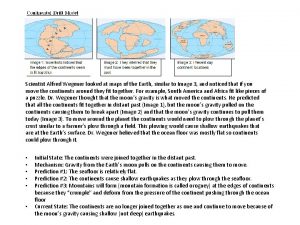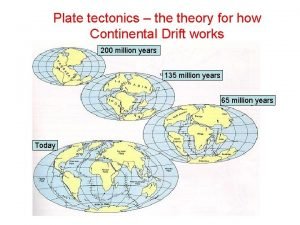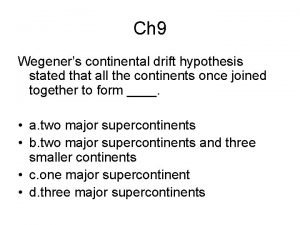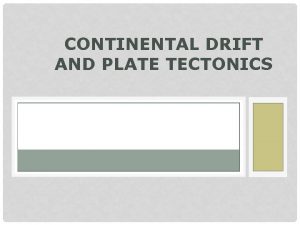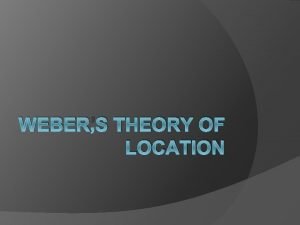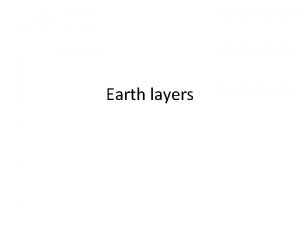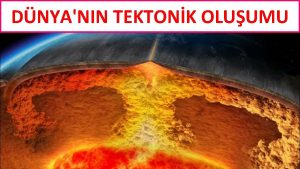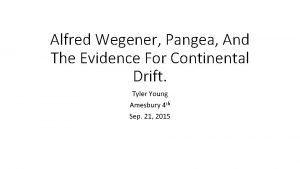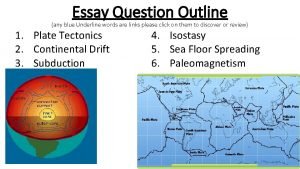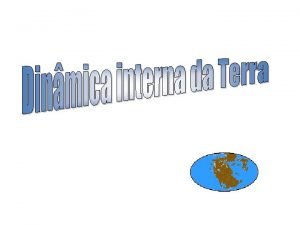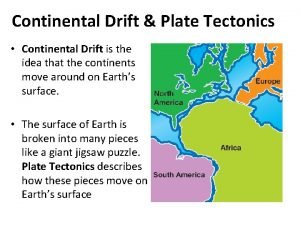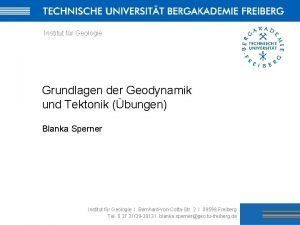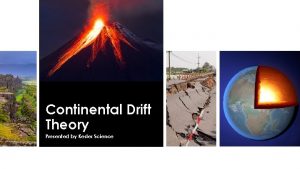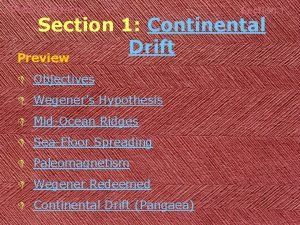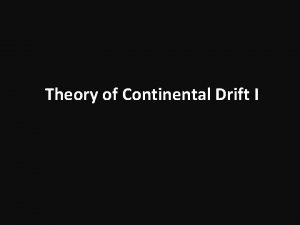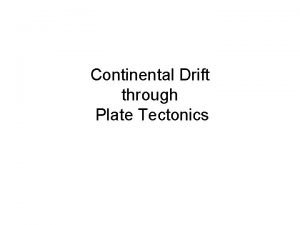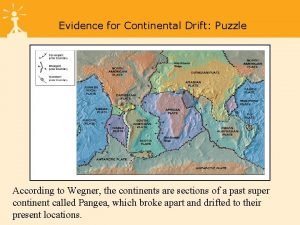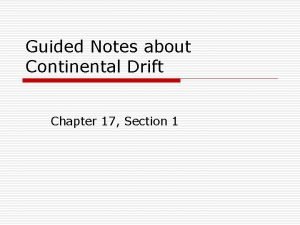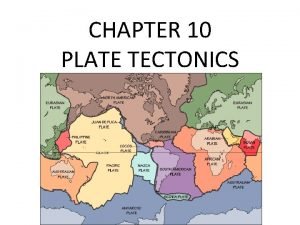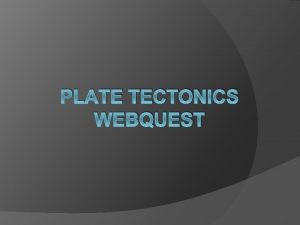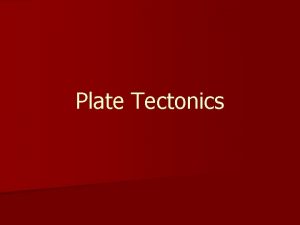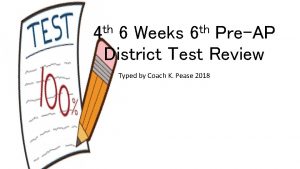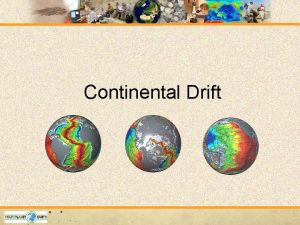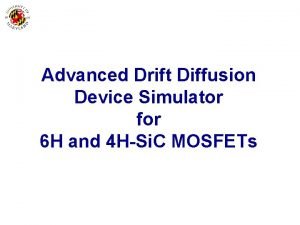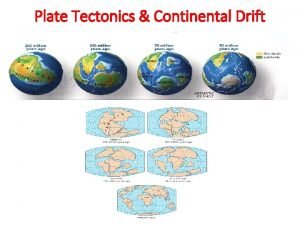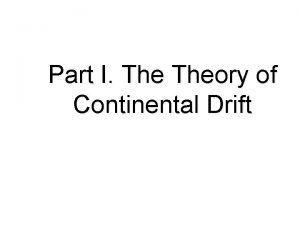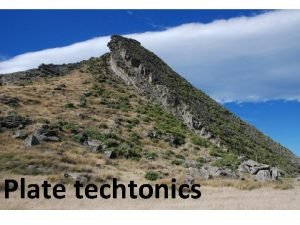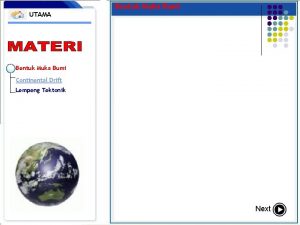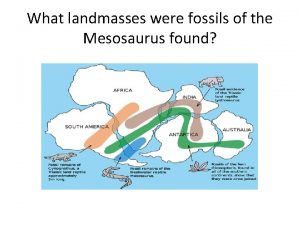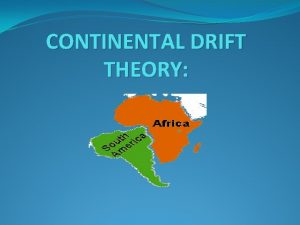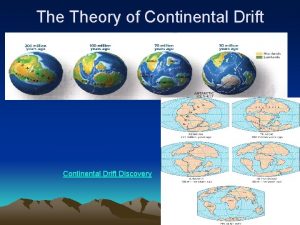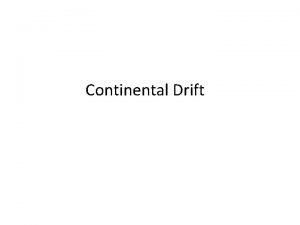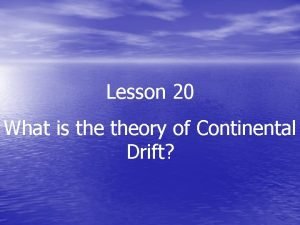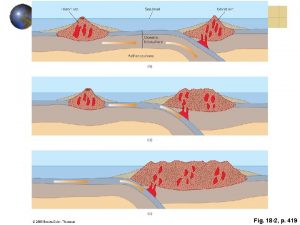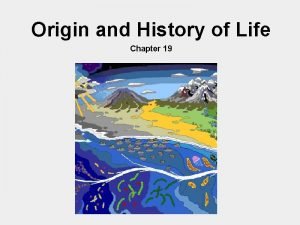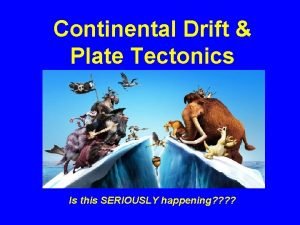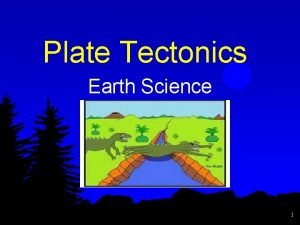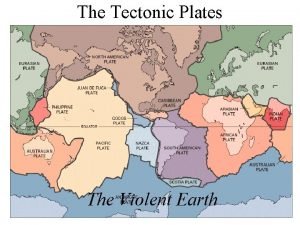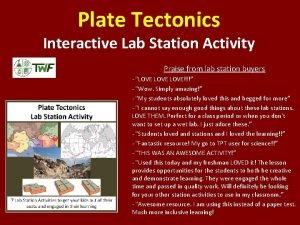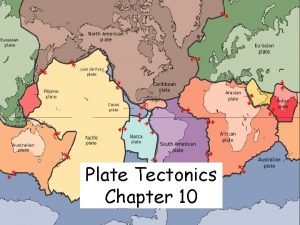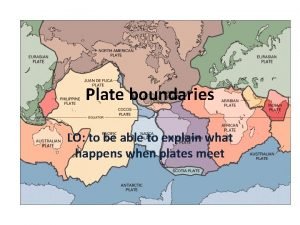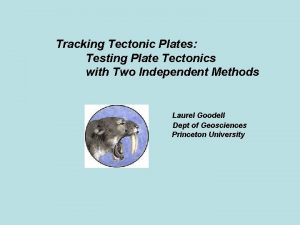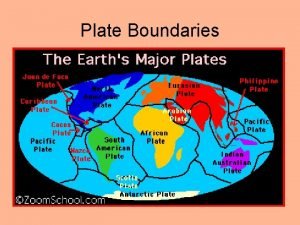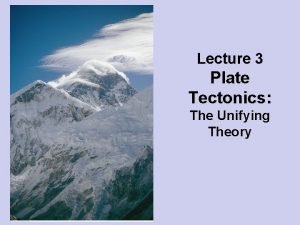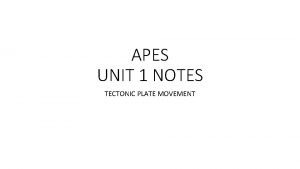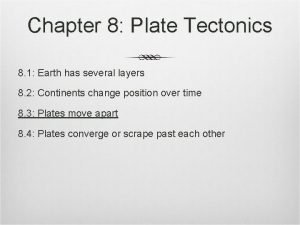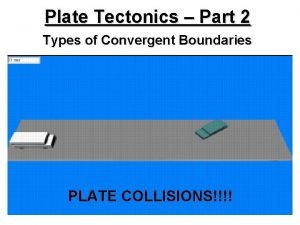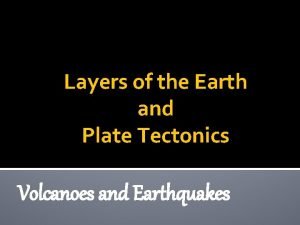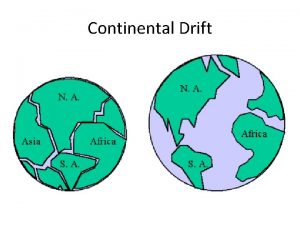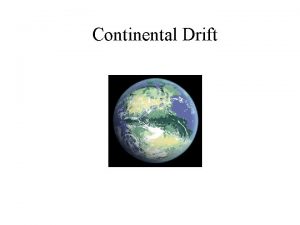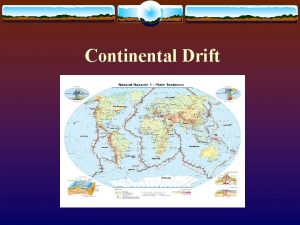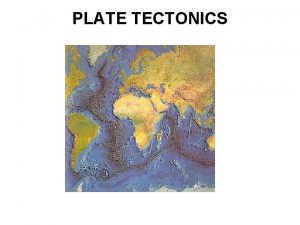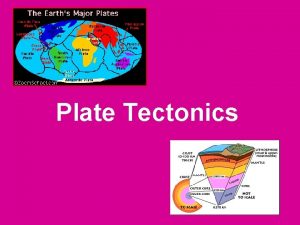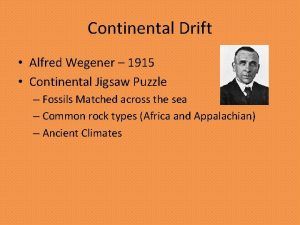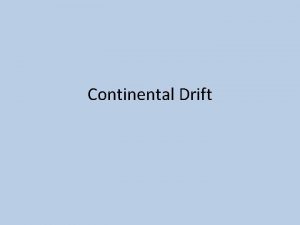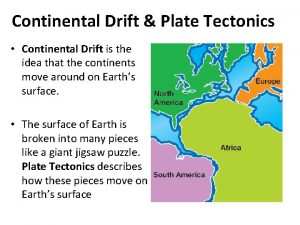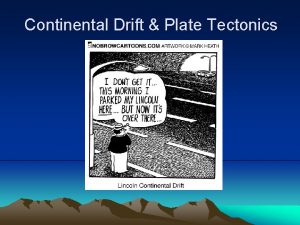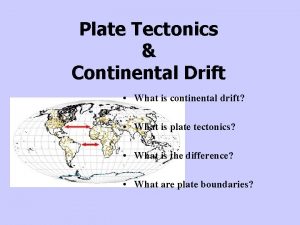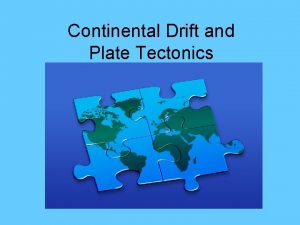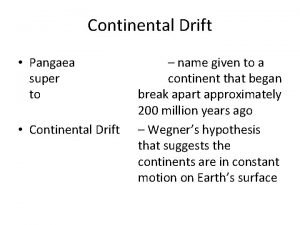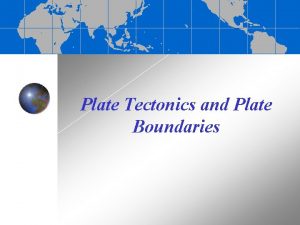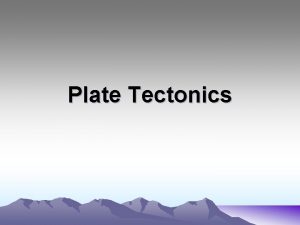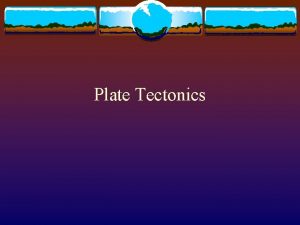Plate Tectonics Alfred Wegener 1915 Continental Drift Pangaea































































- Slides: 63

Plate Tectonics Alfred Wegener 1915 Continental Drift





Pangaea






Sonar

Atlantic Ocean

World Ocean Floor

Magnetic Field Magnetic north is several degrees off geographic north, and it also wanders around.

Rocks and magnetism Fe-rich minerals record the direction of ‘north’ as well as their latitude as they crystallize. Basalt, the kind of rock that makes up oceanic crust, has Fe-rich minerals.

Magnetic Reversals The Earth’s magnetic field reverses every so often. When this happens, magnetic north becomes located near the South Pole.

Magnetometer readings show that basaltic rocks have the same readings on either side of the MOR (mid-oceanic ridge).

Magma generation at MOR

Basalts are youngest along the MOR, where they are generated, then get progressively older away from, and on either side of, the MOR.

Seafloor Spreading Generation of basalt at mid-oceanic ridge


Tectonic Plates 3 major types





Pillow Basalt Lava extruded in water takes the form of ‘pillows. ’


Divergent Plate Boundaries MOR is 42, 000 miles long

Triple Junction Initial formation of a divergent plate boundary takes the form of several triple junctions. As spreading continues, one of the rift valleys has to fail: Aulacogen

East African Rift Aulacogen






Mature Divergent Boundary

3 types of convergent plate boundaries: 1) Oceanic-Continental 2) Oceanic-Oceanic 3) Continental-Continental

Oceanic-Continental Convergence Accretionary Wedge Volcanic arc appears approx. 200 miles inland from the trench. Magma pulses separated by about 400 years. Partial melting creates continental crust (we’ll discuss later).

Oceanic-Oceanic Convergence Older, and thus colder & denser, crust subducts. Similar to oceanic-continental convergence, but forms volcanic island arc.

Earthquake Distribution Map Distribution of earthquakes mirrors the tectonic boundaries.

Benioff Zone Deeper earthquakes are always found far inland of the trench.

Continental-Continental Convergence Ocean-bottom sediments forced upward. Collision happens after oceanic crust is completely consumed during continental-oceanic subduction. Continental crust is not dense enough to be forced down into the mantle.

Collision

Himalaya

India-Asia Collision


Trenches: Where oceanic crust is subducting

Transform Plate Boundary

San Andreas Fault

Segments Each segment moves at a different rate, some not at all

Earthquake Hazards

Mantle Plumes Subducting oceanic crust melts at the core-mantle boundary, releasing lots of magma. Magma rises to the surface over a 600, 000 year period.

Hawaii

Hawaiian hot spot Hot spot is fixed Plate moves over hot spot


Hawaiian Hot Spot

Hot Spots




Earth
 Plate tectonics vs continental drift
Plate tectonics vs continental drift Continental drift theory and plate tectonics theory
Continental drift theory and plate tectonics theory Continental drift vs plate tectonics theory
Continental drift vs plate tectonics theory Compare continental drift and plate tectonics
Compare continental drift and plate tectonics Convergent plate boundary
Convergent plate boundary What type of plate boundary
What type of plate boundary Who was alfred wegener and what did he theorize
Who was alfred wegener and what did he theorize Alfred wegener biographie
Alfred wegener biographie Fixismus
Fixismus Material index formula weber
Material index formula weber คือ
คือ Ccuator
Ccuator Convergent plate boundary
Convergent plate boundary Tillitler
Tillitler Picture of alfred wegener
Picture of alfred wegener Picture of alfred wegener
Picture of alfred wegener 1912 alfred wegener
1912 alfred wegener 7 lithospheric plates
7 lithospheric plates Continental drift adalah
Continental drift adalah Continental drift theory
Continental drift theory Section 1 continental drift
Section 1 continental drift Proof of continental drift theory
Proof of continental drift theory Continental drift warm up
Continental drift warm up Continental drift puzzle
Continental drift puzzle Continental drift theory slideshare
Continental drift theory slideshare Continental drift notes
Continental drift notes Chapter 10 plate tectonics
Chapter 10 plate tectonics Continental drift webquest
Continental drift webquest Evidence of continental drift
Evidence of continental drift Proof of continental drift theory
Proof of continental drift theory Continental drift michael sammartano
Continental drift michael sammartano Continental drift theory
Continental drift theory Glacial scars continental drift
Glacial scars continental drift Continental drift simulator
Continental drift simulator Continental drift
Continental drift Fossil correlation continental drift
Fossil correlation continental drift Paleoglaciation definition
Paleoglaciation definition 7 lempeng bumi utama
7 lempeng bumi utama Continental drift
Continental drift The continental drift theory
The continental drift theory Continental drift discovery
Continental drift discovery Continental drift theory
Continental drift theory Continental drift
Continental drift Continental drift
Continental drift Glacial evidence of pangea
Glacial evidence of pangea Continental drift
Continental drift Continental drift
Continental drift Convergent boundaries features
Convergent boundaries features What causes tectonic plates to move? *
What causes tectonic plates to move? * Tectonic plates
Tectonic plates San andreas fault
San andreas fault Plate tectonics interactive lab
Plate tectonics interactive lab Summarize the theory of plate tectonics
Summarize the theory of plate tectonics Constructive plate boundary diagram
Constructive plate boundary diagram Plate motion calculator
Plate motion calculator Future plate tectonics
Future plate tectonics Unifying theory of plate tectonics
Unifying theory of plate tectonics Tectonic plates apes
Tectonic plates apes Plate tectonics definition
Plate tectonics definition Chapter 8 plate tectonics
Chapter 8 plate tectonics Boundaries of plate tectonics
Boundaries of plate tectonics Plate boundaries song lyrics
Plate boundaries song lyrics Arthur holmes contribution to plate tectonics
Arthur holmes contribution to plate tectonics Edible plate tectonics
Edible plate tectonics



